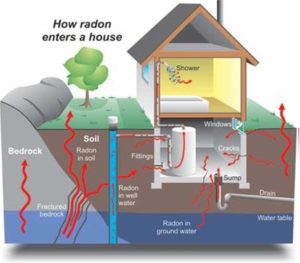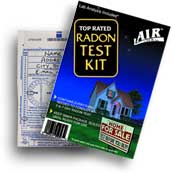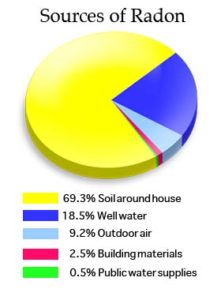Every house in Colorado is different, but one thing they could have in common is the risk of radon.
New and old homes, well-sealed and drafty homes, and homes with or without basements all have the potential to have radon issues, which could lead to significant health problems. Radon has been found to be the leading cause of lung cancer among non-smokers in the U.S. and claims approximately 21,000 lives annually, nationwide.
 Radon is a colorless, odorless, naturally occurring radioactive gas emitted from the breakdown of uranium in rocks and soil. Normally, radon gas rises up through the soil and dissipates into the air outside of buildings. Air pressure inside a home is usually lower than pressure in the soil around the house’s foundation. Because of this difference, the house acts like a vacuum, drawing radon in through foundation cracks and other openings. Concerns about radon arise when it accumulates in the home after seeping through openings — cracks, loose-fitting pipes, sump pits, dirt floors, slab joints or block walls.
Radon is a colorless, odorless, naturally occurring radioactive gas emitted from the breakdown of uranium in rocks and soil. Normally, radon gas rises up through the soil and dissipates into the air outside of buildings. Air pressure inside a home is usually lower than pressure in the soil around the house’s foundation. Because of this difference, the house acts like a vacuum, drawing radon in through foundation cracks and other openings. Concerns about radon arise when it accumulates in the home after seeping through openings — cracks, loose-fitting pipes, sump pits, dirt floors, slab joints or block walls.
Building awareness
“Measuring radon levels in the home is simple and inexpensive,” says Wendy Rice, family and consumer science Extension agent in La Plata County. “All homes in Colorado should be tested. The geology in La Plata County makes radon a particular problem there with approximately 49 percent of homes with unhealthy (greater than 4 pCi/L) radon levels.”
For the past seven years, Rice has been working with home and business owners as well as local residents in four counties in southwestern Colorado (La Plata, Montezuma, San Juan and Archuleta). She provides educational sessions for residents, students, stakeholders, HOAs, builders and Realtors.
Rice is continually seeking other venues in which to reach those potentially affected by radon exposure. This year she started doing some marketing to provide resources in medical care provider offices.
“If health care providers are going to ask if a patient has smoke detectors, it is a great segue to raise the question if they have screened for radon in the home,” she noted.
Only individual testing can determine which buildings may have a radon problem. The radon level in one home cannot be gauged on a neighboring test result. Every house is different, but all have the potential to have radon issues.
Committed to local issues
Extension offices throughout the state offer free educational programs on radon testing and mitigation. Five counties have received funding by the Colorado Department of Public Health and Environment (CDPHE) to provide educational programs to homeowners and, in some cases, businesses, to help people learn to detect radon. In Larimer County, for example, agriculture and natural resources Extension agent Karen Crumbaker works with day-care personnel so that they can meet health department requirements at their facilities. Children are at higher risk because their respirations per minute are significantly faster than an adult’s, and on Jan. 14, 2016, the CDPHE passed a ruling requiring all day-care facilities in the state to conduct radon testing in their facility by May 1, 2017.
“I was asked by the Larimer County Department of Health and Environment to educate day-care facility personnel on how to conduct a radon test in their facility,” Crumbaker said. “Through the grant, I have 13 programs scheduled in the next two months, and each day-care facility will receive free test kits for the appropriate number of rooms they need to test.”
The City of Fort Collins Healthy Sustainable Homes Program supports the educational programs for childcare facilities located within the city by providing free test kits.
Extension’s outreach approach varies, depending on the needs of a community. In Park County, Extension agriculture and natural resources agent Deb Lester works with the county development services department, which includes building and zoning, the county nurse in the public health department, as well as a dental hygienist. The public health department sponsors brown-bag lunch sessions offered by Extension, and the county development services department maintains a list of companies that do radon mitigation.
“Since radon is common in the mountains we have a lot of interest,” Lester said. “We try to do three to four workshops a year, and then go where people are, to health fairs and booths at the county fair, Bailey Days, Alma’s Walk in the Cloud Days and the Evergreen Rodeo.”
Mark Platten, in Teller County, provides two short-term radon kits, a DVD and other handouts to participants. He has established distribution points at the county seat in Cripple Creek: at the public health department, the building and planning department and his office.

“I also help people interpret their results and provide information on installing mitigation systems,” he said.
An effective outreach effort is also the classes he provides for realtors and builders.
“Because radon has been found to be a cancer-causing radioactive gas that you can’t see, smell or taste, its presence in the home can pose a danger to the entire family’s health,” said Platten. “More home buyers and renters are asking about radon levels, and radon is part of the disclosure statement when purchasing a home.”
It is possible to use a Flexible Spending Account or High-Deductible Health Plan funds to pay for mitigation.
Expanding the educational efforts to online venues has proved valuable to Chaffee County Extension Director Kurt Jones.
“I reach people through webinars, so folks can stay at home or at work,” Jones said. “By mailing the radon kits to them ahead of time, they have time during the webinar to actually set the kits out and test during the webinar.”
For more information, view the Extension fact sheet “Preventing Radon Problems in the Home.”
